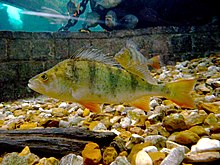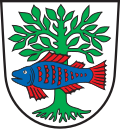European perch
| European perch | |
|---|---|

| |

| |
| Scientific classification | |
| Domain: | Eukaryota |
| Kingdom: | Animalia |
| Phylum: | Chordata |
| Class: | Actinopterygii |
| Order: | Perciformes |
| Family: | Percidae |
| Genus: | Perca |
| Species: | P. fluviatilis
|
| Binomial name | |
| Perca fluviatilis | |

| |
| Distribution: native range introducedrange
| |
| Synonyms[2] | |
TheEuropean perch(Perca fluviatilis), also known as thecommon perch,redfin perch,big-scaled redfin,English perch,Euro perch,Eurasian perch,Eurasian river perch,Hatch,poor man's rockfishor inAnglophoneparts of Europe, simply theperch,is apredatoryfreshwater fishnative toEuropeandNorth Asia.It is thetype speciesof thegenusPerca.
The perch is a populargame fishforrecreationalanglers,and has been widelyintroducedbeyond its native Eurasian habitats intoAustralia,New ZealandandSouth Africa.Known locally simply as "redfins", they have caused substantial damage to native fish populations in Australia and have been proclaimed a noxious species inNew South Wales.[3]
Taxonomy
[edit]The firstscientific descriptionof the river perch was made byPeter Artediin 1730. He defined the basic morphological signs of this species after studying perch fromSwedishlakes. Artedi described its features, counting the fin rays scales and vertebrae of the typical perch.[4]
In 1758,Carl Linnaeusnamed itPerca fluviatilis.[5]His description was based on Artedi's research.[4]
Because of their similar appearance and ability to cross-breed, theyellow perch(Perca flavescens) has sometimes been classified as asubspeciesof the European perch, in which case itstrinomial namewould bePerca fluviatilis flavescens.[6]
Description
[edit]
European perch are greenish with red pelvic, anal and caudalfins.They have five to eight dark vertical bars on their sides.[2][7]When the perch grows larger, a hump grows between its head and dorsal fin.[8]
European perch can vary greatly in size between bodies of water. They can live for up to 22 years, and older perch are often much larger than average; the maximum recorded length is 60 cm (24 in). The British record is 2.8 kg (6 lb 2 oz), but they grow larger in mainland Europe than in Britain. As of May 2016, the official all tackle world record recognised by theInternational Game Fish Association(IGFA) stands at 2.9 kg (6 lb 6 oz) for a Finnish fish caught September 4, 2010.[9]In January 2010 a perch with a weight of 3.75 kg (8 lb 4 oz) was caught in the riverMeuse,Netherlands.[10]Due to the low salinity levels of theBaltic Sea,especially around theFinnish archipelagoandBothnian Sea,many freshwater fish live and thrive there. Perch especially are in abundance and grow to a considerable size due to the diet ofBaltic herring.
Distribution and habitat
[edit]The range of the European perch coversfresh waterbasins all over Europe, excluding theIberian peninsula.Their range is known to reach theKolyma RiverinSiberiato the east.[2]It is also common in some of the brackish waters of theBaltic Sea.[11]
The European perch lives in slow-flowing rivers, deep lakes and ponds. It tends to avoid cold or fast-flowing waters but some specimens penetrate waters of these type, although they do not breed in this habitat.[11]They are most abundant in relatively shallow lakes and lakes with deep light penetration, and less abundant in deep lakes and those with low light penetration.[12]
Introduction outside Europe
[edit]European perch has been widely introduced, with reported adverse ecological impact after introduction.[2]In Australia, the species is implicated in the decline of the now-endangered native fish, theMacquarie perch.[13]
Behaviour and reproduction
[edit]The European perch is carnivorous, with juveniles feeding onzooplankton,bottominvertebrate faunaand other perch fry, while adults feed on both invertebrates and fish, mainlysticklebacks,perch,roachandminnows.[11]Perch start eating other fish when they becomefingerlingsat a size of around 120 mm (4.7 in).[1]
Male perch become sexually mature at between one and two years of age, females between two and four.[1]In theNorthern Hemispherethey spawn between February and July.[11][2]Males reach spawning areas ahead of females, and court mates by chasing through underwater vegetation. During reproduction, the female lays a white ribbon of eggs up to one meter long, which is deposited on water plants or on the branches of trees or shrubs immersed in the water.[2]There has been speculation, but only anecdotal evidence, that eggs stick to the legs of wading birds and are then transferred to other waters.[14]
The eggs hatch after a period of 8 to 16 days. The larvae are 5 millimetres (0.20 in) long on hatching, and live in open water where they feed onplankton.Juveniles migrate to areas nearer the shore and bottom during their first summer.[2]
Diseases and parasites
[edit]Cucullanus elegansis a species of parasitic nematode. It is an endoparasite of the European perch.[15]Juvenile perch are commonly infected byCamallanus lacustris(Nematoda),Proteocephalus percae,Bothriocephalus claviceps,Glanitaenia osculata,Triaenophorus nodulosus(allCestoda) andAcanthocephalus lucii(Acanthocephala).[16]
Predators
[edit]
The European perch is a frequent prey of manyfish-eatingpredators such as theWestern osprey(Pandion haliaetus),[17]great cormorant(Phalacrocorax carbo)[18][19]andcommon kingfisher(Alcedo atthis),[20][21]and it is an important item in the diet of the globally threatenedDalmatian pelican(Pelecanus crispus).[22]Other non-avian predators include thenorthern pike(Esox lucius) and theEurasian otter(Lutra lutra).[23]
Relationship with humans
[edit]Fishing
[edit]

European perch is fishedfor foodand asgame.[11]Its flesh is described as good eating, with a white, firm, flaky texture and well flavoured.[24]According toFAOstatistics, 28,920 tonnes were caught in 2013. Largest perch fishing countries wereRussia,(15,242 tonnes),Finland(7,666 tonnes),Estonia(2,144 t),Poland(1,121 t) andKazakhstan(1,103 t).[11]
Baits for perch includebaitfishes(e.g.minnows,goldfish),weather loaches,pieces of rawsquidor pieces of raw fish (mackerel,bluey,jack mackerel,sardine), orbrandling,red, marsh, andlob worms,maggots,shrimp(Caridina,Neocaridina,Palaemon,Macrobrachium) and peeledcrayfishtails. Thetacklesneeded are fine but strong.
Artificial luresare also effective, particularly for medium-sized perch. It is possible tofly fishfor perch usingartificial fliestied for the purpose. Often, the flies required are "streamers" or bait-fish imitations and use flash, colour and movement to entice a take from the perch.[25]
Perch in culture
[edit]
The European perch isFinland's national fish.[26]
It is also pictured in emblems of several European towns and municipalities, such asBad Buchau,GröningenandSchönberg, Plön.
The raw fish item in the gameFactoriois a plush toy of the European perch.[27]
See also
[edit]References
[edit]- ^abcFreyhof, J.; Kottelat, M. (2008)."Perca fluviatilis".IUCN Red List of Threatened Species.2008:e.T16580A6135168.doi:10.2305/IUCN.UK.2008.RLTS.T16580A6135168.en.Retrieved19 November2021.
- ^abcdefgFroese, Rainer; Pauly, Daniel (eds.) (2019)."Perca fluviatilis"inFishBase.December 2019 version.
- ^"Redfin perch".NSW Government. Archived fromthe originalon 12 February 2017.Retrieved23 January2017.
- ^abJohn Thorpe (1977).Synopsis of the biological data on the Perca fluviatilis Linnaeus, 1758 and Perca flavescens Mitchill, 1814(PDF).FAO.ISBN9251005044.
- ^Eschmeyer, William N.;Fricke, Ron & van der Laan, Richard (eds.)."Perca fluviatilis".Catalog of Fishes.California Academy of Sciences.Retrieved12 September2020.
- ^Bailly, N (2015)."Perca fluviatilis flavescens (Mitchill, 1814) – unaccepted".World Register of Marine Species.Retrieved24 January2016.
- ^"Perch (Perca fluviatilis)".ARKive.Wildscreen. Archived fromthe originalon 2017-02-02.Retrieved25 January2017.
- ^"Perch".Luontoportti.Retrieved25 January2017.
- ^"Official World Record".The International Game Fish Association.Retrieved23 January2017.
- ^"Fischdaten".Fisch-Hitparade(in German). 2010.Retrieved23 January2017.
- ^abcdef"Species Fact Sheet (incl. link to FishStat)".FAO.Retrieved17 October2015.
- ^Seekell, David A.; Byström, Pär; Karlsson, Jan (2018)."Lake morphometry moderates the relationship between water color and fish biomass in small boreal lakes".Limnology and Oceanography.63(5): 2171–2178.doi:10.1002/lno.10931.ISSN1939-5590.S2CID53998313.
- ^"The feasibility of excluding alien redfin perch from Macquarie perch habitat in the Hawkesbury-Nepean Catchment | NSW Department of Primary Industries".dpi.nsw.gov.au.Retrieved2021-01-31.
- ^"Is there (scientific) proof that water fowl can transport fish eggs from one water body to an other?".2014.Retrieved23 January2017.
- ^"Cucullanus elegans Rudolphi, 1802".World Register of Marine Species.Retrieved24 January2017.
- ^Kuchta, R., Čech, M., Scholz, T., Soldánová, M., Levron, C., Škoríková, B. (2009)."Endoparasites of European perch Perca fluviatilis fry: role of spatial segregation".Diseases of Aquatic Organisms.86(1): 87–91.doi:10.3354/dao02090.PMID19899354.
{{cite journal}}:CS1 maint: multiple names: authors list (link) - ^"Osprey Fact File".Scottish Wildlife Trust.Retrieved12 September2020.
- ^Čech, M., Čech, P., Kubečka, J., Prchalová, M., Draštík, V. (2008). "Size selectivity in summer and winter diets of great cormorant (Phalacrocorax carbo): Does it reflect season-dependent difference in foraging efficiency?".Waterbirds.31(3): 438–447.doi:10.1675/1524-4695-31.3.438.JSTOR25148353.S2CID84199917.
{{cite journal}}:CS1 maint: multiple names: authors list (link) - ^Čech M., Vejřík, L. (2011). "Winter diet of great cormorant (Phalacrocorax carbo) on the River Vltava: estimate of size and species composition and potential for fish stock losses".Folia Zoologica.60(2): 129–142.doi:10.25225/fozo.v60.i2.a7.2011.S2CID90464667.
{{cite journal}}:CS1 maint: multiple names: authors list (link) - ^Čech M., Čech P. (2015)."Non-fish prey in the diet of an exclusive fish-eater: the Common Kingfisher Alcedo atthis".Bird Study.62(4): 457–465.doi:10.1080/00063657.2015.1073679.S2CID85632259.
- ^Čech M., Čech P (2017). "Effect of brood size on food provisioning rate in Common Kingfisher Alcedo atthis".Ardea.105(1): 5–17.doi:10.5253/arde.v105i1.a3.S2CID90362897.
- ^"Dalmatian PelicanPelecanus crispus".Birdlife.Retrieved12 September2020.
- ^Kloskowski, Janusz; Rechulicz, Jacek & Jarzynowa, Barbara (2013). "Resource availability and use by Eurasian ottersLutra lutrain a heavily modified river-canal system ".Wildlife Biology.19(4): 439–451.doi:10.2981/12-104.S2CID86028541.
- ^"Perch".Scottish Government.Retrieved30 August2020.
- ^"Perch On The Fly".Fishtec.2016-11-28.Retrieved2018-11-12.
- ^Weaver, Fran (2014)."Iconic Finnish nature symbols stand out".thisisFinland.Finland Promotion Board. Archived fromthe originalon 25 October 2017.Retrieved28 January2017.
- ^"Friday Facts #348 - The final GUI update".Reddit.Retrieved16 December2022.

